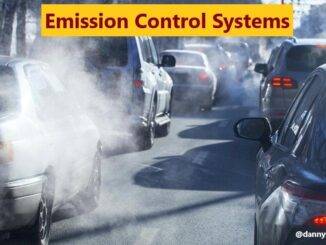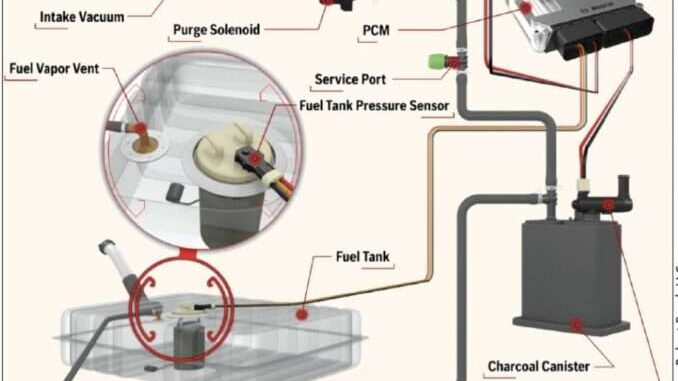
The function of the (EVAP) evaporative emission system, is to trap and store evaporative fuel emissions.
Therefore, the (EVAP) evaporative emission system totally eliminates fuel vapors, as a source of air pollution.
However, sealing the fuel tank is not as simple as it sounds. For one thing, a fuel tank must have some type of venting, so air can enter to replace the consumed fuel.
As a result of the (EVAP) evaporative emission system, removing fuel vapors, and other emissions. So, if the fuel tank was air tight, the fuel pump could create enough negative pressure, to collapse it. Consequently, on older (EVAP) systems, the tank is vented, by a spring-loaded valve, inside the fuel cap. While, on newer vehicles it is vented, through the (EVAP) canister.
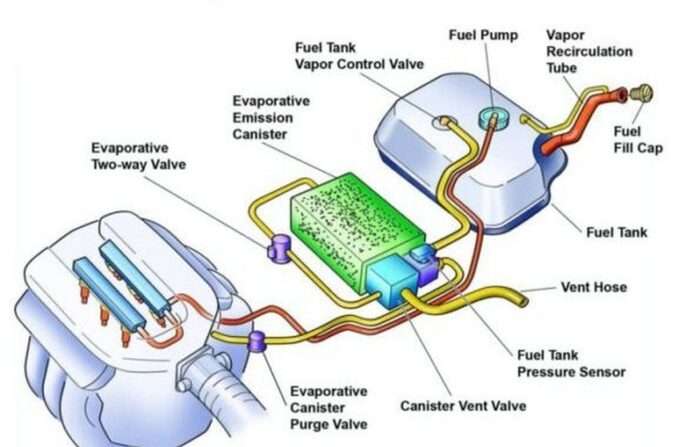
Consequently, a typical system consists of:
- A small canister full of charcoal
- Valves
- Hoses
- Vents in the fuel lines
- A sealed fuel tank cap
When fuel evaporates inside the fuel tank, the excess vapors are transferred, to the charcoal canister. They’re stored there, until they can be safely transferred, back to the engine. Finally, they are burned, with the normal air/fuel mixture.
The most obvious symptom of an (EVAP) system problem, is the Check Engine light (CEL) coming on. A common cause of this, is a loose fuel cap. So, if you’ve recently filled up on fuel, check that the fuel cap is fully tightened.
Consequently, if the Check Engine Light (CEL) remains on after checking the fuel cap, there may be a bigger problem.
(EVAP) System Components:
- Fuel Tank
- Fuel Cap
- Liquid-Vapor Separator
- (EVAP) Canister
(EVAP) Evaporative Emission Common Problems
All (EVAP) systems have a charcoal canister. The canister has a huge surface area, that is effective in storing vapors from the fuel.
So, if the charcoal canister were to go bad, there would be an array of problems. In addition, to power reduction, fuel odor, more pinging, lower fuel economy, and flooding.
So, there are some common problems, with the (EVAP) system. Most often, with the Purge Valve, that vents fuel vapors to the engine. The Canister Purge Valve, also commonly referred to as the “purge valve”, is an important component of your (EVAP) system. Also, any leaks in the system itself, can be anywhere, and are hard to find.
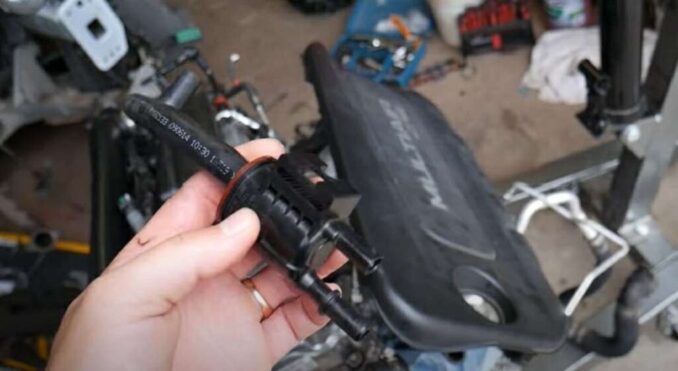
Consequently, this system restricts the fuel vapors created in your fuel tank, from escaping into the atmosphere, by trapping them. So, when your engine runs at regular speed. The evaporative emission (EVAP) system, slowly allows these vapors back into your engine.
So, the Canister Purge Valve, controls the flow of these vapors. Consequently, the valve regulates when, and how much of these vapors enter your engine. Another name for the canister purge valve, is the “solenoid”.
The Most Common Purge Valve Issues Are:
- The Valve Is, Stuck open.
- The Valve Is, Stuck closed.
- It may just not open, at the proper time.
(EVAP) Evaporative Emission Canister Purge Valve Failure Signs:
Check Engine Light (CEL) Is On
- So, the first sign of trouble for your canister purge valve is, the Check Engine Light (CEL) coming on. If your (ECU) detects higher or lower than expected purging, it will turn on the Check Engine Light (CEL). Consequently, setting off error codes.
Purge Valve, Stuck Closed
- Also, if your canister purge valve is not opening properly, it may negatively impact your fuel mileage. Now, those vapors end up in the environment. As a result, you will lose a portion of the fuel, regularly used in burning.
Purge Valve, Stuck Open
- So, if your canister purge valve is stuck open, a vacuum leak is created. Simply put, air will be allowed to enter the engine, in a quantity that is not predicted by your computer. This will change the engine’s air/fuel ratio, and can cause rough idling, as well as difficulty starting.
- Therefore, if experienced together, there is a high likelihood, of a failing canister purge valve. Furthermore, this enriches the fuel mixture, and will likely foul the spark plugs. So, most charcoal canisters, have a replaceable filter.
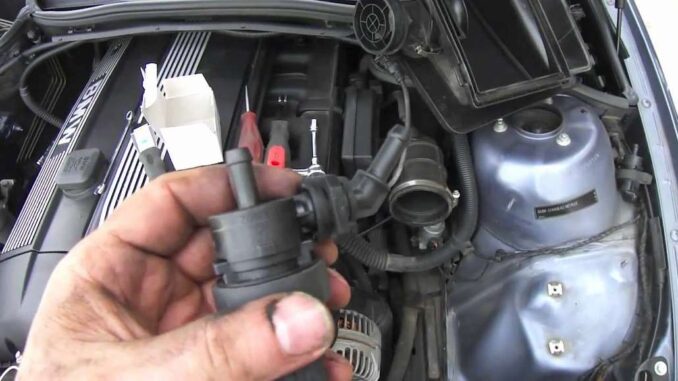
(EVAP) Evaporative Emission Canister Purge Valve Testing
So, this test is really about finding leaks in the system.
Using An Engine Vacuum Gauge
Firstly, all (EVAP) systems use, intake manifold vacuum to operate. So, an engine vacuum gauge, is the perfect tool to use. First, verify the engine idle vacuum, is around 21 in. Hg (inches mercury). Next, with the engine running, and the purge valve disconnected. Check for vacuum in the (EVAP) system – there should be none. However, if there is vacuum. Then, that tell you the valve is stuck open.
Using A Hand Held Vacuum Pump
So, you can check some (EVAP) Purge Valves, with a hand held vacuum gauge. And, without the need for the engine to be running. Unpowered, the purge valve should be closed, and the vent valve should be open. The vacuum gauge will show you if the valve is holding pressure or not. Then, you can manually power the purge valve, on and off. This checks its operation and sealing. (sometimes done, with a 9v battery)
Smoke Test (The Best Way)
So, the idea behind the smoke test is simple. You blow smoke into the (EVAP) system, and look for smoke leaking from a failing valve, seal, tube, or hose.
The Purge Valve Solenoid, can also be tested electrically. But, we will save that, for another blog post.
Possible (EVAP) Evaporative Emission Fault Codes:
- P0440….Evaporative Emission Control System Fault
- P0441….Evaporative Emission Control System Incorrect Purge Flow (Common In Some Hyundai Models)
- P0442….EVAP Emission Control System Leak Detected (small leak)
- P0443….EVAP Emission Control System Purge Control Valve Circuit
- P0444….EVAP Purge Control Valve Circuit Open
- P0445….EVAP Purge Control Valve Circuit Shorted
- P0446….Evaporative Emission Control System Vent Control Circuit (Common In Some European Models)
- P0447….EVAP Emission Control System Vent Control Circuit Open
- P0448….EVAP Emission Control System Vent Control Circuit Shorted
- P0449….EVAP Emission Control System Vent Valve/Solenoid Circuit
- P0450….Evaporative Emission Control System Pressure Sensor
- P0451….EVAP Emission Control System Pressure Sensor
- P0452….EVAP Emission Control System Pressure Sensor Low Input
- P0453….EVAP Emission Control System Pressure Sensor High input
- P0454….EVAP Emission Control System Pressure Sensor Intermittent
- P0455….EVAP Emission Control System Leak Detected (gross leak)
- P0456….EVAP Emission Control System Leak Detected (small leak)
- P0457….EVAP Emission Control System Leak Detected (fuel cap)
Conclusion
Firstly, the (EVAP) evaporative emission system, prevents the escape of fuel vapors, from the fuel system. So, when the engine is running, the purge valve opens. This allows vacuum to siphon the fuel vapors, into the engine.
In addition, fixing (EVAP) codes, can be a challenge, even for a professional. Finally, if you have, a P0442 small leak code, you may need, a smoke machine to find it.
BY DANNY BENDER




